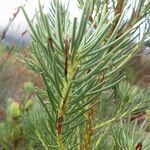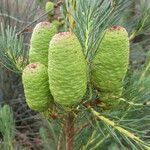Shrubs up to 4 m, with a single stem at the base but branching immediately into several stout erect stems with a smooth light grey bark; male plants not as robust but more branched. Branches straight, erect, stout in female plants, often purplish. Leaves terete, glabrous, mucronate, slightly grooved on the upper surface, semi-patulate, in male plants up to 4.1 cm long, 1.2 mm diam., in female plants up to 5.8 cm long, 1.5 mm diam. Involucral leaves similar to the stem leaves, pale green to ivory in colour, not much crowded, not concealing the head. Male inflorescence 4 cm long and 1 cm diam., solitary, terminal, spicate, glabrous, pedunculate, giving off an unpleasant odour. Basal bracts clothing the peduncle, 5 mm long and 1.2 mm broad, about 30 in number, glabrous, short-ciliate, swollen at the base, tapering to the acute apex. Floral bracts 1.3 mm long and 1.3 mm broad, acute, short-ciliate, standing with the floret on a swollen base. Floral bud 5 mm long, straight, erect, glabrous except for a few short hairs, green, not much swollen at the apex. Perianth tube 1 mm long, glabrous except for a few short hairs on the lateral segments. Claw 3 mm long, glabrous, recurved 180°. Limb 2 mm long, glabrous, concave. Anther 1.5 mm long, curling upward. Stigma abortive, 1.5 mm long, clavate, often minutely bifid, acting as a pollen presenter. Style 4 mm long, glabrous., Hypogynous scales 1 mm long, stout, pale yellow, exuding nectar at the apex. Pollen triangular in polar view with sides 30 µ, polar depth 20 µ. Receptacle 3.5 cm long and 1.5 mm diam., narrowly cylindrical. Female inflorescence 2.8 cm long and 1.2 cm diam., solitary, terminal, elongated-ovoid, giving off an unpleasant musty odour, growing in length as the florets open progressively towards the apex, with the florets arranged in 13 ascending spirals of about 11 in each, with a stout peduncle 8 mm long. Basal bracts 7 mm long, 2.5 mm broad, about 34 in number, caudate, glabrous, short-ciliate, imbricating the peduncle. Floral bracts 2.5 mm long and 4.2 mm broad, broadly oval, glabrous, sparsely short-ciliate, connate towards the base. Floral bud 4.7 mm long, compressed, tapering to the blunt glabrous apex, sparsely pubescent. Perianth tube 2.5 mm long, compressed, sparsely short-pubescent. Claw 1.2 mm long, sparsely short-pubescent, recurved 90°. Limb 1 mm long, glabrous. Staminode 0.5 mm long. Filament distinct from the perianth segment above. Ovary 0.7 mm long, ovoid, glabrous. Style 3 mm long, glabrous. Stigma 0.3 mm diam., oblique. Hypogynous scales 1 mm long, stout, pale yellow. Nectar secreted from the apex of the scale is transferred to the throat of the perianth tube in the groove at the junction of the adjacent perianth segments. Receptacle 2 cm long and 5 mm diam., cylindrical. Mature female head cone-like, indehiscent, 4-9 cm long and 2.4-3.9 cm diam., with many closely spaced glabrous bracts arranged in three adnate spirals. Fruit a samara, 7 mm long and 6 mm broad, narrowly winged, dark brown or mottled, flat, heart shaped, emarginate.
More
Shrub, erect, branching from base, 2-4 m high, dioecious. Leaves needle-shaped, shallow upper groove, hairless, 41 x 1.2 mm, in males, 58 x 1.5 mm in females, apex with fine point; involucral leaves slightly crowded, pale green to ivory-coloured, not concealing capitula. Male flowers in terminal spike, 40 x 10 mm, unpleasant odour. Female flowers in terminal, elongate-ovoid capitula, 28 x 12 mm. Involucral bracts > 30. Mature capitulum 40-90 x 24-40 mm; bracts hairless, in 3 abutting spirals. Flowering time Oct.-Mar. Fruit retained.
Stout, dioecious shrub to 4 m. Leaves needle-like, ± 40 mm long (male), ± 58 mm long (female), involucral leaves similar, pale green to ivory. Male flower heads spike-like, ± 40 mm long, female narrow, ± 28 mm long, foetid.




